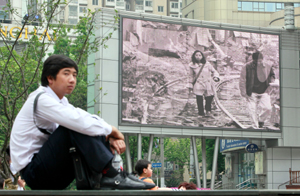One of our news alerts on Monday detailed the harassment reporters faced as they tried to cover the anniversary of the Sichuan earthquake, one of China’s greatest natural disasters. Today, on the anniversary, newspapers marked the event with strong coverage. That’s a world of difference from the years of coverage that obscured the breadth of destruction and the extent of fatalities in the Tangshan earthquake of 1976.

While today’s papers centered on the Sichuan anniversary, they also reported on China’s first case of H1N1 infection. And that, too, was a far cry from the media response to the SARS outbreak of 2003. (Thanks to David Bandurski at Hong Kong University’s China Media Project for linking to a compilation of May 11 and 12 front pages across China at the aggregator site news.qq.com.)
Thus continues the nuanced progression of media and government control in China. In her year-end essay on China last year in Attacks on the Press, CPJ’s
The Sichuan earthquake ushered in a moment of heightened activity for China’s news media. Reporting on the devastating 1976 Tangshan earthquake had been officially quashed; by contrast, Chinese journalists sweeping into Sichuan in May ignored propaganda regulations and helped drive a national outpouring of grief and philanthropy. The country’s commercially oriented news outlets led the way, buoyed by eyewitness accounts that outpaced the censors at the Central Propaganda Department. Their coverage was so compelling that even media under direct control of the central government followed their lead: CCTV broadcast live from the quake zone, and China Daily published a rare “exclusive” from the northwestern city of Mianyang. The media’s energy was matched, for the most part, by professionalism. Newspapers and Web sites scaled down entertainment news ahead of an official three-day mourning period marked with striking black-and-white front pages.
The deployment of Prime Minister Wen Jiabao to the disaster zone helped the propaganda department recapture the narrative. At the same time, authorities began applying the heavy-handed tactics often used to control sensitive national stories. When Sichuan parents of children killed in the collapse of flimsy school buildings began to call for accountability, Sichuan bylines disappeared from print and police manhandled both local and foreign reporters covering protest vigils by grieving parents.
The China Media Project’s director, Qian Gang, is famous for his breakout 1986 investigative book on Tangshan, “The Great China Earthquake,” in which he reported that 250,000 people were killed. His reporting on Tangshan and his leadership of CCTV’s “News Probe” investigative reporting show have given him great credibility. His May 7 article on Sichuan is an insightful look at what he calls the “complex environment’ in which the quake and its aftermath unfolded. It is partially a timeline of media coverage, but read the section titled “The Political Logic of News Controls.” Here is an excerpt:
In the official response to reporting on the Sichuan earthquake, we also saw signs of emerging changes to media control and censorship in China, what we have called at the China Media Project “Control 2.0.″ It is fair to say that media controls in mainland China have never slackened, but “control” has undergone many changes, not just in methods and tactics but also in the standards applied to control. What should be controlled and what not? What should be controlled more strictly? What areas can be loosened?
There should be no doubt that there hasn’t been a “Post-Olympics Spring” in China’s local and central governments’ approach to media control. But at the same time, the situation remains dynamic, with an increasingly sophisticated, media-consuming audience driving the government (and the news media) from the blanket cover-ups of the past.
By the way, an English-language version of Qian Gang’s book was published in 1989 by The Foreign Language Press in Beijing. The reporting was terrific and the assessment of the government’s cover-up was seminal.